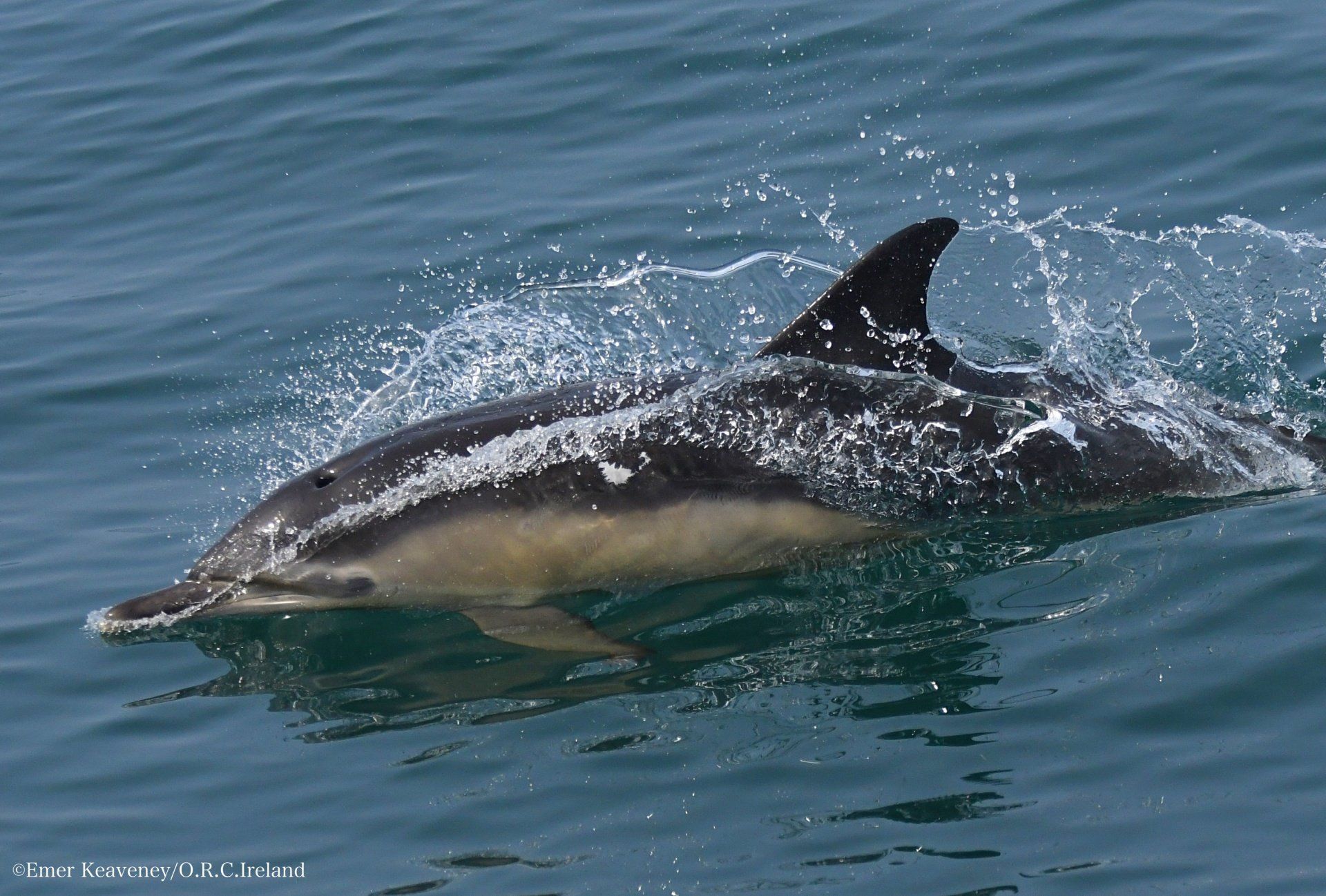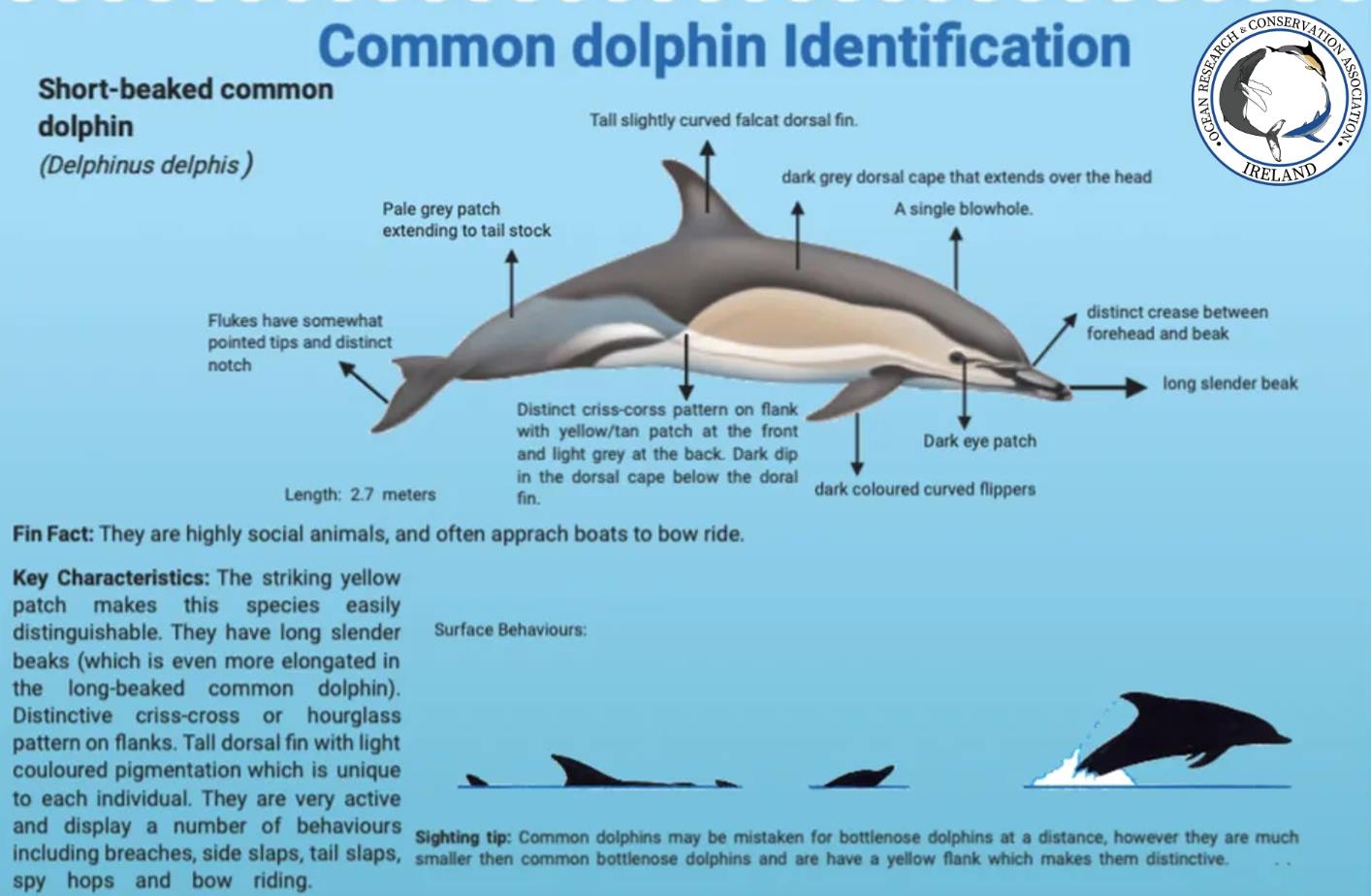Classification:
Kingdom:
Animalia
Phylum:
Chordata
Class:
Mammalia
Order:
Artiodactyla
Infraorder:
Cetacea
Family:
Delphinidae
Genus:
Delphinus
Species: Delphis
Get the Facts:
Short-beaked common dolphin (Delphinus delphis) are among the most abundant of marine mammal species. They are sometimes found in groups of over 3000 individuals.
Species Identification:
Short-beaked common dolphins are small in comparison to the bottlenose dolphin. As adults, males are slightly larger than females. They have a rounded forehead (known as a melon), a relatively long rostrum, and 40 to 57 pairs of small sharp teeth in each jaw. Their body is sleek with a relatively tall, triangular dorsal fin positioned in the centre of their back. Short-beaked common dolphins can be easily identified by their distinctive colour pattern, which is often referred to as an ‘hourglass.’ A dark grey cape extends along the back from the head to just below the dorsal fin where a "V" is visible on either side of the body, creating an hourglass shape. Ahead of the dorsal fin, behind the head, is a yellow/tan panel that contrasts with their dark back, and the side of the body behind the dorsal fin is light grey. A narrow dark stripe extends from the lower jaw to the flipper, and there is a complex facial colour pattern that includes a dark stripe from the rostrum, or “beak,” to the flipper. The eye is not typically within the stripe, but the eye stands out due to a patch of dark pigment around it. The colour patterns of young and juvenile short-beaked common dolphins are somewhat more muted and pale than older, adult dolphins. Considerable variation in colour patterns are evident within populations but more markedly different coloration patterns are evident in some distant geographic areas.
Diet:
Short-beaked common dolphins are carnivores (piscivores). Their diet consists of many species of fish and squid that live less than 200 metres deep. These dolphins also eat small fish, such as herring, sand-eels, mackerel, cod, haddock, as well as squid and octopus.
Habitat:
Short beaked common dolphin are sighted on all coasts of Ireland and are the most frequently observed and stranded species, particularly along the south coast. They can be found in both coastal and offshore habitats in groups of 10 to a up to a thousand or more individuals. Short-beaked common dolphins can be sighted all year round, however, during the summer months (April to September), sightings increase as they likely move inshore following prey availability.
Behaviour:
Short-beaked common dolphin are highly social and interact with boats and vessels, often approaching them to bow ride. They engage in a variety of surface behaviours, from co-operative feeding aggregations, to acrobatic breaches and leaps, side slaps, tail slaps, pec-rubbing and spy-hopping. Their leaping and splashing can often be seen from a great distance, sometimes several kilometres. They are excellent swimmers and are capable of covering large distances in a short period of time. It is also a fast swimmer and can reach speeds of over 60km/hr.
Social Structure:
Common dolphins are considered a social species as they travel in schools ranging from dozens to hundreds, or even thousands of individuals. Maternal kinship may also influence associations in common dolphins, with pairs of dolphins with the same mtDNA haplotypes, assumed to belong to the same maternal lineages, more likely co-occurring in the same schools.
Vocalisations:
Common dolphins produce a number of vocalisations, including whistles, clicks, and burst pulse calls. Whistles are frequency modulated, long duration, tonal calls used for communication and often have harmonic structure as well. Clicks are short duration, broadband-pulsed calls used in echolocation and navigation, and range from 23 to over 100 kHz. Burst pulse calls are a series of rapidly produced clicks perceived as tonal sounds and occur both in echolocation and communication. Common dolphins also produce buzzes and other non-whistle pulsed sounds, occasionally referred to as barks, yelps, or squeals.
Reproduction:
In the eastern North Atlantic short-beaked common dolphins have been reported to have a pronounced seasonality of reproduction, with both conception and parturition occurring during summer (May to September). Males become sexually mature at the average age at attainment of sexual maturity was 8 - 13 years, with the average age being 11 years. Moderate sexual dimorphism and large testes suggest sperm competition and a promiscuous mating system, with female common dolphins mating with multiple mates. Length of gestation period in short-beaked common dolphins in the eastern North Atlantic has been estimated at approximately 11.5 months. Only moderate sexual dimorphism exists, and males are only slightly larger than females. One characteristic that can help identify sexually mature males is the presence of a prominent post-anal hump. This may serve in female mate selection, allowing the identification of the healthiest male, that is, the male that can produce the largest quantity of sperm may have the largest postanal hump. The lifetime reproductive output in female common dolphins in the eastern North Atlantic is relatively low (about 4 calves), and female common dolphins in this region exhibit a low pregnancy rate (28.2%). Evidence of the existence of sperm competition within the species and a low reproductive output suggests that female common dolphins may be partaking in one or more of the following mating strategies: mating with multiple mates to ensure that male offspring inherit competitive ejaculates; avoiding inbreeding; manipulating the uncertainty in knowledge of paternity to diminish the risk of infanticide; ensuring genetic compatibility with one of the males, thus increasing the likelihood of fertilising her ova; and diminishing the risks of mating with an infertile male (Murphy & Rogan, 2006).
Lifespan:
Short-beaked common dolphin have a lifespan of 25 - 28 years.
Common dolphins of the World:
There are two species of common dolphin. The short-beaked common dolphins and the closely related to long-beaked common dolphins. Once thought to be a single species, the two species differ slightly in size, appearance, and habitat preference. Both common dolphin species are slender, with a long distinct beak and a tall dorsal fin. The most distinguishable difference, as the name suggests, is the beak, which in the long-beaked common dolphin can be up to 10% of the total body size. The long-beaked common dolphins also have distinctive colouring with multiple colour bands along their sides.Both species are predominantly black or dark grey in colour, and forward of the dorsal fin their flanks have a yellow patch whilst behind the dorsal fin it is white and grey. This colouration forms a beautiful hourglass pattern on their sides which can be less obvious in the long-beaked form.
Long-beaked common dolphin have a disjointed distribution but are generally found within 180 km offshore in the Atlantic, Indian and Pacific Oceans. In contrast to the short-beaked common dolphin that is typically found in oceanic waters, the long-beaked form seems to prefer shallower, warmer waters and generally lives closer to shore.
Global Distribution:
Common dolphins are, as the name suggests, widely distributed throughout tropical and temperate waters, and can be found in both nearshore and offshore environments. Short-beaked common dolphin occur through-out temperate and tropical oceans. They are found in the Atlantic, Pacific, Mediterranean and Caribbean Seas. Long-beaked common dolphin have a more restricted range than short-beaked common dolphin and is found in coastal areas in tropical and warmer temperate seas. It is found in western and southern Africa, South America, California, Mexico, Peru and Japan, Korea and Taiwan.
Population Status:
The short-beaked common dolphin is listed as Least Concern on the IUCN Red List. This is a very abundant species, with many available estimates for the various areas where it occurs. In the Atlantic, abundance in European continental shelf waters was estimated at 63,400 in 2005 (SCANS-II project; P. Hammond pers. comm.). Offshore, abundance in a block bounded by 53-57ºN and 18-29ºW was estimated at 273,000 (Cañadas
et al. in press). West of the Bay of Biscay, 62,000 common dolphins were estimated in the fishing grounds of the albacore tuna driftnet fishery in 1993 (Goujon, 1996). In the western North Atlantic, 121,000 were estimated to occur (Waring
et al. 2006).
Conservation Threats:
Short-beaked common dolphin face a number of human induced threats, such as interactions with fisheries, through bycatch, ship-strike, disturbance from eco-tourism and chemical, plastic and noise pollution. Bycatch is perhaps their most pervasive threat and a significant number of common dolphins are
accidentally caught in fisheries through-out their range. In France, he Bay of Biscay is a particular "hotspot" for bycatch and it is estimated that up to 10,000 dolphins may have been killed by interactions with fishing gear in winter 2019. In Ireland, strandings of short-beaked common dolphin have also been increasing on an annual basis since 2009. Read more here.







